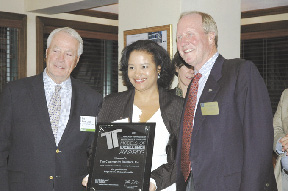According to The Community Builders (TCB), Morgan Woods affordable housing development in Martha's Vineyard has won the 2008 Urban Land Institute's J. Ronald Terwilliger Workforce Housing Models of Excellence Award.
Felicia Jacques, director of development for the Northeast region, accepted the award in Miami on behalf of TCB.
The award recognizes exemplary developments that meet workforce housing needs in high cost communities. Entries are judged on criteria including: extent of affordability, involvement of public/private partnership, energy cost savings, green construction and innovative building technologies that reduce cost and improve efficiency.
"We are proud to be honored by the Urban Land Institute for our commitment to exceptional workforce housing," said Patrick Clancy, president and CEO of TCB.
The Morgan Woods project is a 60-unit, 21-building rental community on 12 acres, and is an example of a community-driven affordable housing effort. Developed in partnership with TCB and the town, Morgan Woods is a cluster development project that addresses the critical need for affordable and workforce housing on the island of Martha's Vineyard. The project utilized innovative, custom-designed modular housing to offset the high cost of new construction on the island and meet a construction schedule that needed to avoid the summer ferry traffic. The project now serves as a model for future workforce housing developments across the country.
Like many seaside communities, the town's economy is driven primarily by seasonal tourism - catering mostly to summer visitors. This influx of part-time residents forces real estate prices higher and higher so that most full-time residents cannot afford to buy or rent a home year-round.
The site-design approach for Morgan Woods uses "cluster development" principles. This concept breaks down the scale of the project to promote a sense of small neighborhoods within the development as opposed to large multi-family buildings or sub-division layouts that are more typical in a development of this scale. The site is organized around three clusters of housing units arranged around landscaped "commons" that are reminiscent of a traditional New England town center. The architectural treatment is not only appropriate given the surrounding community, but also strengthens the overall aesthetic of the neighborhood. The result is a new community of full-time residents who live and work together on the island they will continue to call home year-round.









